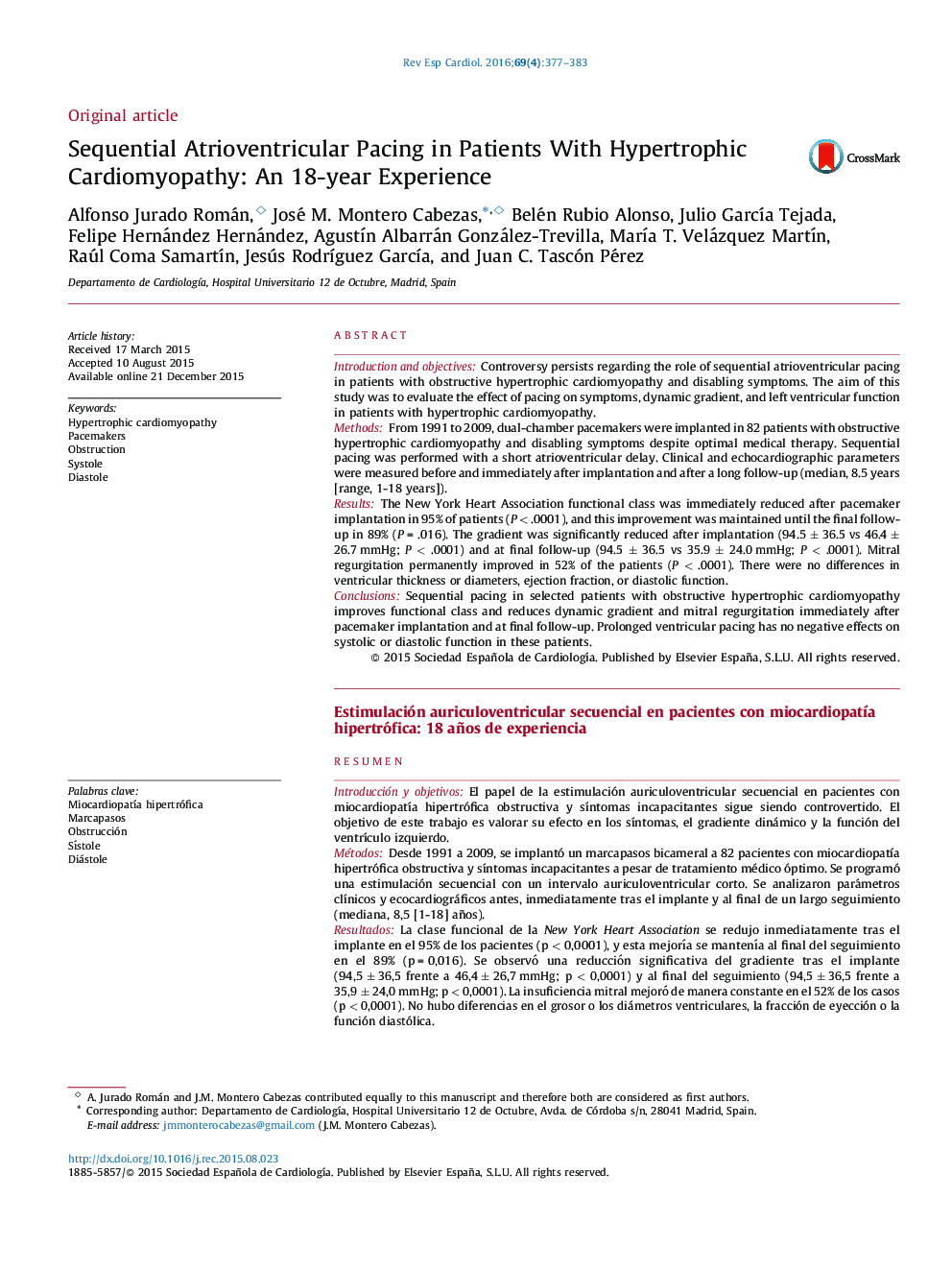| Article ID | Journal | Published Year | Pages | File Type |
|---|---|---|---|---|
| 3016578 | Revista Española de Cardiología (English Edition) | 2016 | 7 Pages |
Introduction and objectivesControversy persists regarding the role of sequential atrioventricular pacing in patients with obstructive hypertrophic cardiomyopathy and disabling symptoms. The aim of this study was to evaluate the effect of pacing on symptoms, dynamic gradient, and left ventricular function in patients with hypertrophic cardiomyopathy.MethodsFrom 1991 to 2009, dual-chamber pacemakers were implanted in 82 patients with obstructive hypertrophic cardiomyopathy and disabling symptoms despite optimal medical therapy. Sequential pacing was performed with a short atrioventricular delay. Clinical and echocardiographic parameters were measured before and immediately after implantation and after a long follow-up (median, 8.5 years [range, 1-18 years]).ResultsThe New York Heart Association functional class was immediately reduced after pacemaker implantation in 95% of patients (P < .0001), and this improvement was maintained until the final follow-up in 89% (P = .016). The gradient was significantly reduced after implantation (94.5 ± 36.5 vs 46.4 ± 26.7 mmHg; P < .0001) and at final follow-up (94.5 ± 36.5 vs 35.9 ± 24.0 mmHg; P < .0001). Mitral regurgitation permanently improved in 52% of the patients (P < .0001). There were no differences in ventricular thickness or diameters, ejection fraction, or diastolic function.ConclusionsSequential pacing in selected patients with obstructive hypertrophic cardiomyopathy improves functional class and reduces dynamic gradient and mitral regurgitation immediately after pacemaker implantation and at final follow-up. Prolonged ventricular pacing has no negative effects on systolic or diastolic function in these patients.
ResumenIntroducción y objetivosEl papel de la estimulación auriculoventricular secuencial en pacientes con miocardiopatía hipertrófica obstructiva y síntomas incapacitantes sigue siendo controvertido. El objetivo de este trabajo es valorar su efecto en los síntomas, el gradiente dinámico y la función del ventrículo izquierdo.MétodosDesde 1991 a 2009, se implantó un marcapasos bicameral a 82 pacientes con miocardiopatía hipertrófica obstructiva y síntomas incapacitantes a pesar de tratamiento médico óptimo. Se programó una estimulación secuencial con un intervalo auriculoventricular corto. Se analizaron parámetros clínicos y ecocardiográficos antes, inmediatamente tras el implante y al final de un largo seguimiento (mediana, 8,5 [1-18] años).ResultadosLa clase funcional de la New York Heart Association se redujo inmediatamente tras el implante en el 95% de los pacientes (p < 0,0001), y esta mejoría se mantenía al final del seguimiento en el 89% (p = 0,016). Se observó una reducción significativa del gradiente tras el implante (94,5 ± 36,5 frente a 46,4 ± 26,7 mmHg; p < 0,0001) y al final del seguimiento (94,5 ± 36,5 frente a 35,9 ± 24,0 mmHg; p < 0,0001). La insuficiencia mitral mejoró de manera constante en el 52% de los casos (p < 0,0001). No hubo diferencias en el grosor o los diámetros ventriculares, la fracción de eyección o la función diastólica.ConclusionesLa estimulación secuencial en pacientes seleccionados con miocardiopatía hipertrófica obstructiva mejora la clase funcional y reduce el gradiente dinámico y la insuficiencia mitral inmediatamente tras el implante y al final de un largo seguimiento. La estimulación ventricular prolongada no produce efectos deletéreos en la función ventricular sistólica o diastólica en estos pacientes.
